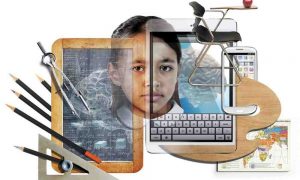India is ‘Gnaana Bhoomi’ – the Land of Wisdom. We have a system of education that is many centuries old. It is not simply a process of teaching and learning. It is much more. It transcends every part of life, every segment of the society and every department of Knowledge.
Ours is a nation that has attached maximum importance to education. The learned, the scholars, the teachers, the Gurus were respected with great awe and admiration. They were placed next only to God. They lived in poverty yet they displayed the highest level of dignity in modesty. The search of these Gurus for absolute Truth could be matched only with the quest of their disciples for pure, supreme Knowledge – the ‘Param Gnana’.
From time immemorial, the ‘Guru- Sishya’ system has been doing wonders and it keeps producing exemplary results benefiting the whole Humanity with reasoning and vision. Most of the times, it revolved around Ethics and Philosophy. Why was it to be so?
Our ancient Gurus and scriptures believed that Ethics and Philosophy were the fundamental elements or basic ingredients for a peaceful harmonious co-existence of all human beings. Anger and lust were two dreaded enemies and the students were trained to ruthlessly crush these two ‘enemies’ and hence were strictly ordered to practice ‘Shantham’(Peace) and ‘Brahmacharya’ (celibacy)while pursuing studies.
These were the norms in almost all Oriental nations. They never found it odd or hard to follow these principles since they knew that those were the rules of the game and nobody had any right to alter it for whatever reason. But unfortunately these strict norms drove many people away from the world of Knowledge and this resulted in education being confined to only a very few. This division resulted in many avoidable inequalities. Every part of the world suffered from this ignominy and India was no exception.
The industrialisation in the West and political uprisings in various countries across the world including the ‘Ahimsa’ struggle in India changed the course of history and the whole perspective and purpose of education changed too accordingly. The shackles were broken; the blockades were demolished and all the conditions attached to formal education were totally removed once for all.
The leaders of free India in the early years of Independence dedicated all their mite in carrying education to all segments of our population and age-old customs and restrictions gave way to a resurgent and revolutionary society where every citizen is entitled to a constitutional right to education.
In the initial stages of freedom, education was entirely a state subject and this helped the leaders to a very great extent in spreading the wings of education. In particular, late shri Kamaraj, former chief minister of the state worked day and night and launched what is very rightly called ‘educational revolution’ in Tamilnadu.
Thanks to shri Kamaraj, who went about his job most earnestly, the state braced itself to literacy and astuteness. As a result, thousands of families in utter poverty rose to become economically sound in a matter of a decade or so. It marked the healthiest social reform that Free India has ever registered in any part of the country.
Many other states followed the suit while many others could not. This has left wide rift in the rate of literacy between different states. Successive governments at the Centre have done their part in the spread of education.
Slowly and steadily India as a whole is surging ahead to be the most potential nation on earth – thanks to Demographic dividend. Education should be the identity of our Land with every passing day driving us closer to the status of the Knowledge Super Power.
For this to happen, we have to remodel our higher education in such a way that it would be the best in the world in terms of adaptability to the demanding conditions and in levels of productivity capable of delivering the best in any (adverse) conditions. Thus we do really need a New Education Policy and that has to be inclusive and expanding.
We can not afford to leave anyone behind. An education that advocates ethics and morality, one that induces people to be peaceful and harmonious and a system that would produce law abiding citizens with utmost commitment to duty may not be easy to find its way through. Yes, we agree. It is so difficult; yet, it is not impossible to achieve.
Let us discuss; let us join hands; let us work; let us make it work.
May the doors of Knowledge be kept wide open and may the Land of Ahimsa become the place of peace and prosperity and May our Wisdom guide us to the Light illuminating the future of all.
The Draft report has many plus and minus points. Here they are –
The PLUS
- The pooling of schools of a certain locality / region and sharing the resources of these schools among themselves for the good of the students is a great idea. (NEP – 15)
- All agriculture universities would be integrated. (NEP – 19)
- Adult education aiming to reach out to as many as possible. (NEP – 21)
- Special Education Zones to serve areas that have relatively less literacy.
The MINUS
- A strong ECCE programme is among the very best investments that India could make with an expected return of Rs 10 or more for every Re 1 invested.’ (NEP-2) Education is all about ‘investment’, ‘return’ and what it means to the growth of national economy. Can there be a more negative, pessimistic approach?
- Completely ignored the aspect of teaching morals in Primary Education (Foundation Level) but speaks of talent search and competitiveness among children.
- Children MUST BE enrolled for pre-school education- says the report. ‘India must absolutely invest in ECCE for all children for all these reasons – equality and justice, ‘employability’ and the prosperity and economic growth of the country’. THIS DANGEROUS SUGGESTION FORCEFULLY SNATCHES THE MOST PRECIOUS CHILDHOOD DAYS FROM THE CHILDREN AND FEOM THEIR PARENTS. The children of 3 years would have to go through the school hours and formal education in schools and Anganwadis. What would be ‘left’ in the children at the end of the day to spend quality time with their parents, grandparents, neighbourhood ‘friends’ and for themselves? This advice of the committee would spell doom for the very survival of the most ancient, most precious institution of India – the Family.
- No reference anywhere to ‘value based education’
- By 2025, every student in Grade 5 and beyond would have achieved foundational literacy and numeracy. Why in 2025? Why not in 2019 itself?
- The report says – ‘we are in severe learning crisis.’ Is it really a learning crisis? Is it not ‘teaching crisis’ for sure? (NEP – 3)
- ‘Memorising’ (rote learning) is not at all bad. It strengthens ‘retention’. THE FOCUS SHOULD BE ON WHAT IS BEING TAUGHT RATHER THAN HOW IT IS BEING LEARNT.
- The report talks about the percentage of dropouts for various Grades. It is not given whether the student dropped out in the first quarter or the last one.
- How can a school drop-out get benefitted by e-learning?
- 21st century skills – not a flawed sentence but a false observation.
- Tech driven system can not be better by itself. (NEP – 20)
- What is the need for a change for 5+3+3+4? (NEP 7)
- Why should we try to create ‘world class’; why should it not be ‘Indian class’?
- No action plan for increase in number of international students coming to India.
- No mention about Open University / Distance Education that would be of great use to those who cannot afford to go any institution yet want to study.
Now, what are our suggestions?
(to continue…
Baskaran Krishnamurthy
Mail: [email protected]




























 WhatsApp us
WhatsApp us
Pingback: Medium Mireille
Pingback: bitcoin exchange
Pingback: Tattoo Supplies
Pingback: 안전놀이터
Pingback: african american wigs online
Pingback: satta king
Pingback: social media marketing agency Hong Kong
Pingback: wig stand
Pingback: w88
Pingback: thenaturalpenguin.com
Pingback: bitcoin evolution review
Pingback: Bitcoin Loophole Platform Review
Pingback: Buy gun optics online
Pingback: 안전공원
Pingback: robotic process automation testing
Pingback: 안전공원
Pingback: human hair wigs
Pingback: Biostar NF61S-M2 TE manuals
Pingback: CABASSE Majorca MC40 manuals
Pingback: DevOps Outsourcing company
Pingback: Tree removal Avon
Pingback: black female full body young gorl for men tpe sex doll
Pingback: 킹스포커
Pingback: forex trading
Pingback: hp sunucu teknik servis
Pingback: block screenshots
Pingback: elo job
Pingback: free facebook login
Pingback: Alrasheed University College |rasheed|alrasheed college
Pingback: digital business transformation services
Pingback: How_life Record Webcam Show From Chaturbate
Pingback: แทงบอลออนไลน์
Pingback: you can try this out
Pingback: buy instagram followers
Pingback: pour plus d'informations